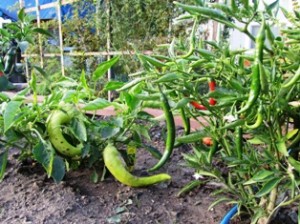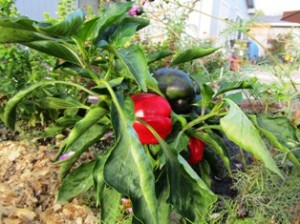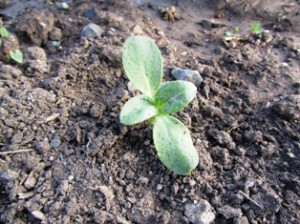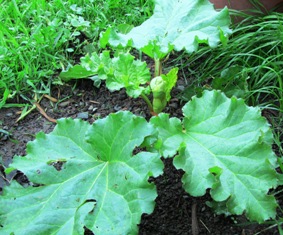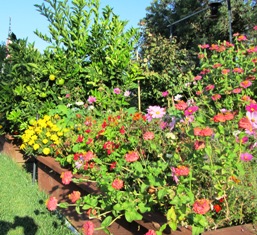Archive for the 'Gardening' Category
Lots of Peppers and Sunflowers Hanging Around
My pepper plants are still producing. It’s a week before Thanksgiving and by this time last year I had harvested all the warm season crops like the peppers. But the plants still have many peppers hanging and are still blooming.
I even have a tomato plant that’s got blooms on it. Of course, most old timer gardeners will tell you that tomatoes won’t set fruit if night-time temperatures aren’t 55 degrees Fahrenheit or higher. So I’ll wait for another week or two to figure out whether or not to pull out the tomato and harvest the peppers. I can use the sweet bells in my Thanksgiving dinner prep.
Yesterday, I laid out on a small stone floor a giant sunflower head that had already dried. The birds, and especially the squirrels, love the seeds. The squirrels practically replant them for me all over the property. The giant sunflower heads laden with seed are my gifts to the wildlife each autumn.
There are sunflowers and then there are the giants that stand seven or eight feet tall with heads the size of dinner plates. The stalks are as thick as the diameter of a coffee mug. It usually takes me a few hours of working with a pick axe to dig out all the stalks and compost them.
I save the seeds from the giants so I can let them dry over the winter and plant again the next year. I’m just guessing but I’ll bet from all the seed heads I’ve saved, I’ve got thousands of seeds. Maybe I’ll package up 50 or so to a bag and give them away at Christmas or sell them at the farmer’s market when it starts up again next year. For now, I’ve got my sights set on making some pepper relish for Christmas season gift baskets of food.
Iris Reward with Sensational Spring Blooms
Few flowers do the double duty of iris in a flower garden. They provide a great background for other flowers and also produce exquisite blooms on their tall stems. Both bearded and beardless iris plants provide textural interest for other perennials, annuals, and herbs, whether in a formal or informal flower bed, along a walkway, or tucked into a corner of a garden.
Iris produce their blooms on stalks that emerge from clumps of stiff, erect, spiked, and pointed green leaves. My iris plants were a gift from the neighbor who owns the property behind the Henny Penny Farmette. The bulbs she gave me had originally been planted by her father and mother, both now deceased. We were thrilled to get the bulbs.
When we planted them on our property, we made sure the soil was amended and we sprinkled in some bone meal and watered well. Then the iris were left alone. We did apply mulch prior to the winter rainy season and because here in the inland valley of the east bay, we can get freezing nighttime temperatures. Those iris plants have rewarded us with spectacular blooms in April each year.
We didn’t know if the bulbs would produce a true blue bloom or some other color, so the anticipation was killing us that first year. Then the buds emerged on tall (roughly three foot stalks) and we could see what was coming. I have to say, the blooms bedazzled us.
Plant height separates the bearded iris into roughly five groups: miniature dwarf, standard dwarf, intermediate, miniature tall, border, and standard tall. Our iris plants fall into the standard tall category. The best time to plant the iris rhizomes is from July to September 15. Set the rhizomes just beneath the soil surface as they do not like being planted too deep. In really cold areas, a thick layer of mulch ensures the rhizome survives alternate freezes and thaws. Lift and divide the rhizomes right after blooming. You can cut the leaves back to six inches for ease in handling the plants.
A note about rhizomes: These thick horizontal stems generate roots from the bottom and the plant’s leaves and flowers emerge from the top. Some plants that grow from rhizomes are bearded irises, calla lilies, and cannas.
Hardy Rhubarb Heralds Spring
I will never forget the long and tortuous Missouri winters of my youth when for days on end the gray sky seemed to hang as low as the horizon line. With hope and great anticipation of nature’s renewal, I waited on spring. Inevitably I would notice the green shoots of tulips, grape hyacinths, and paper white narcissus pushing up through the cold earth.
Gradually, the gray lifted revealing blue. The earth warmed. The strawberries swelled and ripened. The spring peepers kept a chorus down by the pond. Then, inevitably, my grandmother would grab a basket and motion for me to join her in the garden. There we twisted and pulled thick red stalks of rhubarb–one of the earliest vegetables of spring–for pie-making. Grandma always served a dessert at every meal, even breakfast when the white icing she had slathered on just-baked cinnamon rolls would cascade down like melting snow.
So it might not come as a surprise to people who know me that when my husband and I talked about what vegetables we would include in our Henny Penny Farmette garden, I told him rhubarb for jam, jelly, and, of course, pies like my grandmother used to make. We waited until our second year here to put in the rhubarb, and we will let the plants grow for at least a year before harvesting. Next spring, we expect to be able to harvest stalks that are at least an inch thick, possibly for one to two months.
If you’ve never grown rhubarb, you need to know that rhubarb leaves are poisonous. Only the celerylike stalks, with their tart (but also sweet) flavor are used for cooking. You also won’t grow rhubarb from seed but rather from root divisions obtainable at your local nursery. Plant the root divisions (also called crowns) in holes that are about three feet deep and three feet wide and include compost and aged manure with soil. Use mulch to keep the roots moist and to protect them during a hard freeze.
I love the elephant ear-sized leaves and the red stalks (although the stalks can also be green). Best of all, the plant is easy to grow and almost pest free. My favorite variety of rhubarb is the Cherry Red because it is a prodigious producer and has an intensely sweet flavor.
Boxes To Grow Just about Anything
When we arrived at the Henny Penny Farmette our first summer here, the weeds on the property towered over our heads. We knew it would take a lot of work to change the wild, chaotic landscape into something beautiful. After we pulled more weeds than we ever want to remember, we planted a garden, started a bed of herbs, and (during the following bare root season in late January) put in an orchard. That rainy season we had 21 straight days of rain.
My husband Carlos had left to visit his family in the Dominican Republic. The rains didn’t let up. I feared the septic would overflow, take down the young trees, and destroy our herb beds. Near the end of that rainy period, the water level rose high enough to threaten the door into the house. Then the rain stopped.
When Carlos returned, he hired some workers to help us reconfigure the landscape, move dirt, and create a level backyard. We put in a small lawn and gravel paths that defined the entire space at the back of our property. We also raised one area of the yard where the septic could drain in a different direction than the house if it rained like that again.
Carlos incorporated into the overall landscape design several planting boxes in which to grow our berries as well as flowers. The soil here is heavy clay that turns to concrete in the summer. Planting boxes allows us to control the soil, enriching it with nutrients and compost as needed. The gravel paths enable us to move around the acreage during the rainy season, inspecting the boxes of plants, without getting getting mired in mud. The cost to build each box is about $125.00.
Planting boxes allow us to meet each each plant’s needs, for example, acid-soil for blueberries, or great drainage for roses. I first observed raised beds in massive planting boxes during a trip to Russia in the late 1990s. In a centuries-old village along the Volga, I saw vegetables and herbs flourishing under an apple tree planted in the center of a massive box. Our Henny Penny Farmette planting boxes are 4 ft. by 6 ft., so we wouldn’t grow trees in the boxes. However, we have planted a citrus or fruit tree between the boxes. These raised beds in frames truly make it possible to grow almost anything and create a sense of order out of the wild chaos of nature.
Homegrown Strawberries
I used dry straw to mulch my strawberries today. In early October, I gave them a feeding and also added a layer of healthy organic compost that was dry. Strawberries are one of the easiest berries to grow. Give them the right nutrients, lots of sun, plenty of water (especially during growing season), and you’ll be rewarded with plenty of sweet, succulent berries. Rinse and eat them right after picking or dip them in melted chocolate, add a handful to a healthy shake, or drop them into homemade ice cream or a bowl of tart yogurt drizzled with honey–the possibilities are almost endless for enjoying these sweet eatables from the garden.
The soil for strawberries should be fairly rich. A good rule of thumb is to create soil that is 50 percent solid and 50 percent porous space. The latter provides room for plant roots, water, and air. I like to grow my berries in 4 x 6 foot raised beds rather than growing them in a traditional garden bed. The raised beds seem to minimize the problems with snails and slugs. Strawberries need sun and water. If salinity is a problem, plant them in a flat bed bed. They don’t do so well in the desert or places where water salinity poses a problem.
Strawberries are easy to start if you buy a dozen starter plants from your local nursery. Almost any planting container will do . . . an half wine barrel, a wooden crate filled lined with a plastic bag and filled with planting mix, or even an old bucket with some nail holes to permit drainage. Don’t bury the crown; it will rot. Topmost roots should be about a quarter inch below the soil surface.
Many varieties of strawberries reproduce with new plants at the end of runners. You can pinch off the runners or allow them to grow up to 7 to 10 inches apart. If you pinch the runners, you’ll get bigger berries but smaller yields; if you let them grow, you’ll get smaller berries but heavy yields. Check with your local nursery for more information about which strawberry varieties grow best in your area.
Pumpkins Aren’t Just for Halloween
It’s the first day of November and I’ve counted four leftover pumpkins that we didn’t use for Halloween. So I’m considering options of what to do with them.
Option 1. Remove the seeds and save them in a paper envelope for planting next year. I’ll need seeds from both male and female plants to get pumpkins; otherwise, the garden will be filled with only vines.
Option 2. Turn the flesh into pumpkin pie filling. If the pumpkins were those smaller, sweeter French pumpkins that I love for pie making, I’d be feeling more excited. However, these were grown just for the purpose of carving jack-o-lanterns and so I’m not so sure about how sweet the flesh of these will taste. But I might give it a try.
Option 3. Cut and remove the pumpkin seeds, clean and toast them with a little seasoning, and voila, I’ve got a healthy snack.
Option 4. Make pumpkin soup from mashed cook pumpkin. I would mix it with several cups or so of vegetable stock, a small onion, a carrot, 1/2 teaspoon of cinnamon, 1/4 teaspoon of nutmeg, and salt and white pepper (to taste). Add one-half cup of a buttery-tasting chardonnay or white wine and simmer together. For garnish, Id finely chop top shoots of a green onion and/or serve with thin-slices of bread toasted in butter in a skillet or toss flavorful croutons into soup-filled bowls.
Things I’ve learned about pumpkins: They grow best during the warm season and, in fact, the seeds won’t even germinate in cold ground. I’ve grown the semi-bush variety and also the vining pumpkins that love to sprawl. They can spread out 50 to 100 square feet or so per hill. I love to see honeybees venturing inside the open blossoms (these little critters can carry pollen for more than a mile and often travel distances of up to five miles in search of food). Because I welcome these pollinators in my organic garden, I don’t use insecticides. A word of caution for plucking pumpkin stems from the vine: wear gloves as the prickles can be quite sharp.
 Facebook
Facebook Goodreads
Goodreads LinkedIn
LinkedIn Meera Lester
Meera Lester Twitter
Twitter





